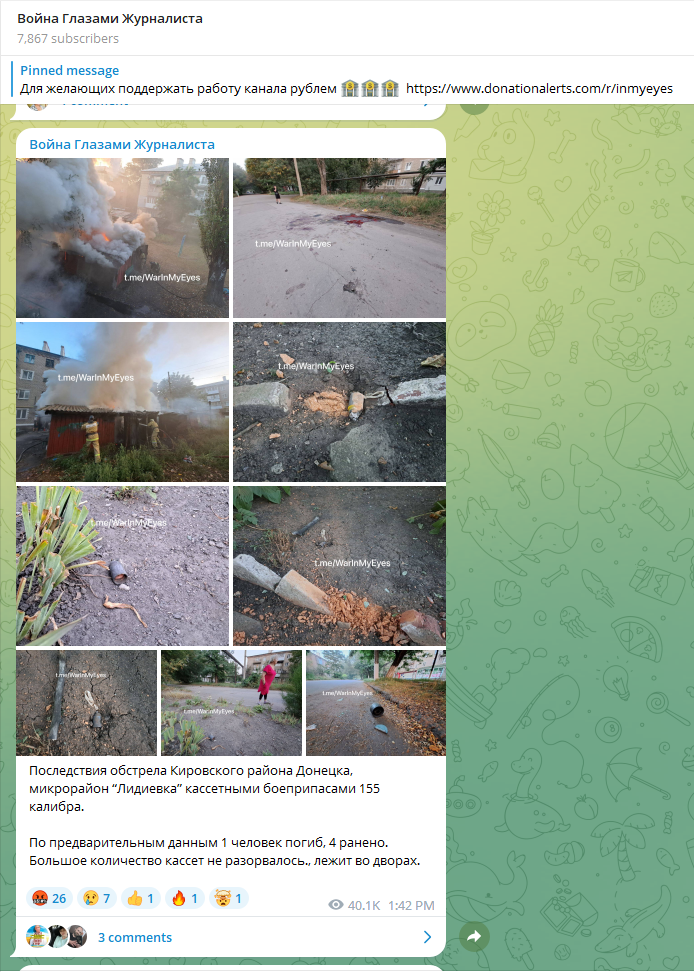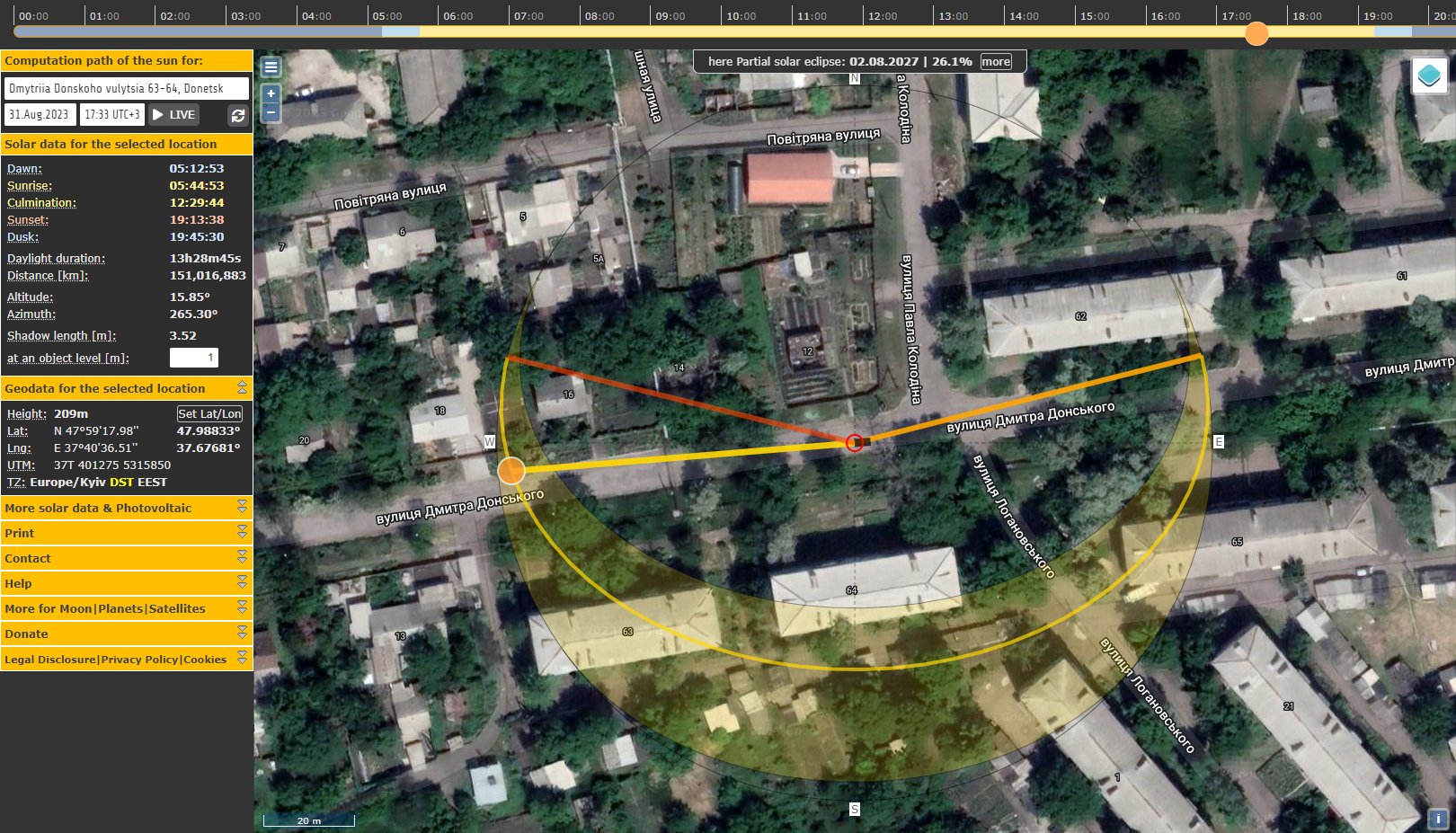Did American Cluster Bombs Injure Civilians in Donetsk?
Published: 24-11-2023
A series of posts were uploaded on August 31st, 2023 to the Telegram channel “Lidievka - where you want to live...” which claimed to depict the “consequences of the shelling of Lidievka”, a neighbourhood in Donetsk (a city in Russian-controlled Ukrainian territory). Videos of the aftermath purportedly show evidence of U.S.-supplied cluster submunitions being used in civilian areas.
This article will attempt to answer the following question:
Using Open-Source Intelligence, to what degree can we verify if U.S.-supplied munitions were used by Ukrainian forces against civilian targets in Donetsk?”
Warning: The following article contains censored images and videos depicting injured civilians in a graphic nature that may be disturbing.
All original media sources are linked at the bottom.
Three Civilian Casualties
(Left) Two injured civilians are lying on a road, surrounded by a large pool of blood. Onlookers are taking in the scene.
(Right) An injured elderly man is sitting on a curb and being aided by a bystander.
Videos and photos submitted into regional Telegram channels were compiled, giving multiple angles of the aftermath. These videos will be geolocated to confirm that these attacks occurred in Lidievka, while sun and shadow analysis will be used to determine if the videos were filmed in a consistent time frame with the social media posts.
In a Russian war journalist’s Telegram channel, images of unexploded ordnance are shown in a series of images showing “a large number (of submunitions) have not burst”
In another Donetsk-region Telegram Channel “Typical Donetsk” (Типичный Донецк), an alternative perspective of the ordnance strike's aftermath is captured, with videos purportedly showcasing the same event, displaying a structure engulfed in flames.
By geolocating this burning structure and determining if the videos with injured civilians were filmed nearby, the degree of certainty of these sources depicting the same event is increased.
Verifying the use of U.S. Cluster Munitions
A contentious debate was settled when President Biden announced that the United States would supply Ukraine with these weapons. Controversy arose partially due to concerns about the potential for civilian harm from unexploded submunitions.
Several Telegram channels contained posts that intertwined images of unexploded submunitions (a.k.a. “duds”) with the previously geolocated videos.
It is crucial to note that none of the analyzed media actually show the ordnance strike. Rather, videos and images show duds and similar fragments lying roadside and on patches of dirt. The majority of images showing submunition duds are close-ups, without much detail in the background.
A Telegram post from In My Eyes, depicting several unexploded submunitions.
Here is a quick background on the submunitions found in the media sources:
Cluster bombs release submunitions to cause explosive damage across a large area. These submunitions are released by a DPICM (dual-purpose improved conventional munition), a general type of munition developed by the United States for effectiveness against both armour and infantry targets, hence the name “dual-purpose”. These weapons are employed in a variety of methods including launching from artillery, surface-to-surface missiles, and by aircraft.
Images of the attack in Lidievka show unexploded M42 and M46 submunitions, matching an image found in CAT-UXO’s repository of unexploded munitions. (Below)
According to the source, both the M42 and M46 are found in a single DPICM. The M46 has thicker walls and “is used in the lower layers of the projectile due to the additional setback loads imposed on the bottom layers when fired”. As a result, it is expected to see this variation of submunitions when DPICMs are employed.
This raises crucial questions: Why are there so many unexploded submunitions (5) shown at Lidievka, and is this a common occurrence when DPICMs are employed?
Many of those studies that have been referenced, at least the ones that I've seen in the press, were based on testing completed in the 1980s, and many of the DPICMs of those variants have since been demilitarized. We're not providing those variants of DPICMs to Ukraine.
Instead, we'll be providing our most modern DPICMs with dud rates assessed to be under 2.35 percent, demonstrated through five comprehensive tests conducted by the Department of Defense between 1998 and 2020. So, we're confident in those numbers.”
This is a matter of debate.
According to the Under Secretary of Defense for Policy, Dr. Colin Kahl in 2023:
On the other hand, some experts dispute these figures.
Marc Garlasco, former Pentagon analyst and senior military analyst at Human Rights Watch:
If we consider the possibility of a dud rate that is suggested by Garlasco, we could expect at least 25 successful detonations of cluster munitions in Lidievka based on the number of undetonated munitions purportedly shown nearby. It should be kept in mind that there is a significant chance for these images to be a part of a coordinated misinformation campaign.
(While this is not a central focus of this investigation’s research question, this possibility reminds audiences to approach videos uploaded to social media with skepticism; especially when these videos cover contentious global conflicts involving actors with a proven expertise in this field.)
CAT-UXO lists the following weapon formats:
“88 x M42/M46 munitions are delivered in a 155mm M483A1 projectile.
180 x M42/M46 munitions are delivered in a 203mm M509A1 projectile.”
And according to militarytoday.com:
“The M864 DPICM… payload consists of 24 M46 and 48 M42”
With only 3 casualties surrounded by relatively dense apartments, and no major visible damage in the surroundings, it is questionable whether cluster bombs were used. If these weapons were truly deployed, it may be expected to see a greater number of civilian casualties and damage to adjacent buildings. Conversely, there may have been a greater number of casualties and damage to buildings which were not reported to press or uploaded to social media.
In addition, it soon became clear that it would be near impossible to verify whether or not these munitions were U.S. supplied, considering the involvement of other nations in supplying cluster munitions to the Armed Forces of Ukraine (eg. Turkey). Nevertheless, this presents an opportunity to continue investigation this event to see if other details can be confirmed.
Testing of CBU-87 and CBU-103 Cluster Bombs at Nellis Air Force Base.
Geolocation
An unknown TV programme displays the testing of a previous-generation artillery fired 155mm DPICM.
Geolocated ordinance impact sites (yellow pins), the breakdown of this process is detailed in the following section.
Here are the locations found:
1. The burning apartments shown in the above videos uploaded online.
2. The site of the three civilian casualties shown in the beginning of this article.
3. A nursery school - images of damage to this building were uploaded online shortly after the ordnance strikes.
To validate the videos uploaded to Telegram, I will begin by geolocating the apartment block with burning metal sheds shown in the videos stills below.
The position of buildings and objects seen in these videos can be used to create a rough sketch to represent how the scene would look from above - or to a satellite.
Prior to conducting a visual search using satellite imagery, the search area is narrowed by looking for clues on Russian social media platforms.
A search on Yandex.com (Russian Search provider) for terms such as “Lidievka”, “shelling”, and “Donetsk” reveals a post on social networking site dzen.ru that claims a local nursery school was damaged, specifically “No. 165”. The time of posting is roughly 2 weeks after the casualty video upload, and is considered potentially relevant.
After verification of this image, the vicinity of the nursery school is used as a starting point for a visual satellite imagery search.
Translated from Russian to English (Google Translate)
The website for the nursery school includes an image with a building façade that matches the one taken by the Telegram user above. This image can therefore be validated as originating from the nursery in the Lidievka Mine Microdistrict.
Identifying the location of the flaming structure, revealing its proximity to the nursery school.
Verifying the flaming structure’s location through satellite imagery analysis. Note the matching double chimneys and façade orientation.
Roughly 160 meters away from the burning structure lies the site of the casualties filmed in the street.
Conclusively, the apartments and casualty videos were filmed in Lidievka Mine Microdistrict. The videos were also filmed in close proximity.
Time & Date Validation
The first of several posts about the attack is uploaded at 10:33 UTC -4 (17:33 UTC +3 Donetsk local time). This time will be used as the input into Suncalc.
Suncalc.org is used to show the expected position of sun at that time, which can be compared to sun’s position in the media sources. When known height objects are filmed, the shadows they produce can also be compared to the expected shadow height for more certainty.
In this case, only approximations can be made, due to the absence of known height objects captured on video.
(Left) A screenshot from the triple casualty video showing the sun position low in the sky, corresponding with the 15.85° altitude returned by Suncalc.
(Right) This image shows how the shadow casted by a person is angled to the left, suggesting that the sun’s position is to the right of the road. This corresponds with the position returned by Suncalc.
Unfortunately, videos showing the burning structure could not be time & date validated due to heavy smoke obscuring the sky.
As a result, these findings suggest with a moderate degree of certainty that the triple casualty video was taken in the late afternoon of August 31st, 2023, roughly around 17:33 UTC +3.
Examining Ordnance Fragmentation Marks
This section analyzes the visible fragmentation marks seen in Lidievka using information from Roly Evans’ Article: “Interpreting Submunition Fragmentation Marks on Hard Surfaces for the Survey of Cluster Munition Strikes” from The Journal of Conventional Weapons Destruction.
Note: This article does not attempt to definitively identify whether cluster munitions were used in Lidievka using fragmentation marks. As Evans explains, visual markings need to be corroborated with associated evidence such as submunition fragmentation, scene contamination can muddle findings, and low resolution images can make discernment between mortar strikes and cluster munitions difficult.
“When a submunition impacts the ground, normally from a high angle, those that function typically spread fragmentation of one form or another. If a submunition impacts a hard surface such as concrete or asphalt, fragmentation can cause distinctive scarring. Different submunitions make differing fragmentation scarring patterns.” - Roly Evans
(Left) An impact mark shown by a reporter, claiming to be in Lidievka shortly after the attack. A central hole is observed, with fragmentation scarring expanding concentrically.
(Right) An impact mark next to the double casualty site, confirmed geolocated in Lidievka. The fragmentation scarring is directional to the right.
“M Series DPICM impact pattern on a tiled hard surface, showing the central hole made by the shaped charge, southern Lebanon, August 2006. Note that the fragmentation pattern is broadly similar to a fin-stabilized submunition, but the shaped charge will likely produce a larger hole at the base of the pattern.” - Evans. (Photo courtesy of Steve Priestley)
Evidently, there are several similarities such as the directionality and density of fragmentation scarring. These details are not definitive proof of cluster munitions as Evans details “be it a submunition such as the 9N210 or AO-1SCh or a standard high explosive mortar, much of the fragmentation will be concentrated on one side of the impact” and “(fragmentation on asphalt) may be tighter than seen on harder concrete surfaces”.
As such, the most glaring similarity to the example from Evans is the central hole, which appears significantly deeper than impact marks of mortars strikes.
Mortar explosion impact in Debaltseve, Ukraine. November 2014. Photo by Sergii Kharchenko/NurPhoto
“Mortar impact patterns, Douma, Syria. Note how the scaring is similar to cylindrical submunition fragmentation patterns. The two are easy to mistake for one another. Also note the same orientation of the three patterns indicating they all came from the same direction and probably from the same mortar barrel. The mortar round tail units are embedded at the base of each pattern." - Evans
While not definitive, these details raise concerns about the potential use of cluster munitions in civilian areas of Donetsk.
As Evans suggests, on-the-ground experts are needed to collect evidence such as stabilizer fins, fuze remnants, and casing materials for reliable confirmations.
Some Alternative Theories
The discrepancies noted above could also be attributed to the following causes:
Analysts have reported that Turkey supplied Ukraine with “Cold War-Era Cluster Bombs”.
Long term storage leading to degradation of munitions quality could explain the large number of duds shown on social media. Also, these Turkish-manufactured munitions may not have the same quality control as American-made and tested units.
2. Additional damage was not uploaded or identified.
The full scope of damage was potentially not entirely shown, and the dud-rate may be consistent with the number of successful munition detonations.
3. There were not cluster munitions, but left similar fragmentation markings.
As Evans notes, mortar strikes have the potential to leave similar markings, and the deep central hole was produced by another munition.
4. These unexploded submunitions were planted as part of a disinformation campaign.
Skeptical researchers have often suggested that various submunitions and fragment imagery are part of Russia’s complex disinformation campaign, aiming to cast blame on adversaries.
Evidently, there remains ambiguity regarding the munition type, the source of these munitions, who fired these munitions, and whether these civilians were targeted purposefully or accidentally.
While the central question of whether or not these attacks show the use of U.S.-supplied cluster munitions remains unanswered, this investigation was a thorough exercise of a variety of OSINT techniques for validating social media posts. This article also demonstrated how a blend of official sources, analyst opinions, and open-source data can cohesively contribute towards the validation process.
Original Media Sources:
Telegram Posts:
https://t.me/itsdonetsk/98020
https://t.me/itsdonetsk/98038
https://t.me/itsdonetsk/98038
https://t.me/itsdonetsk/98043
https://t.me/itsdonetsk/98047
https://t.me/itsdonetsk/98062
Russian News Report:
https://ren.tv/news/v-rossii/1137906-kadry-posledstvii-udara-vsu-po-poselku-shakhty-lidievka-v-donetske
Nursery School Damaged News Report:
https://www.donetsk.kp.ru/online/news/5457740/
Unknown TV Programme displaying the use of artillery fired DPICM:
https://www.youtube.com/watch?v=IroOVamQZHQ
Cluster Bomb Testing At Nellis AFB
https://www.youtube.com/watch?v=TJbWqcVT7IY
























